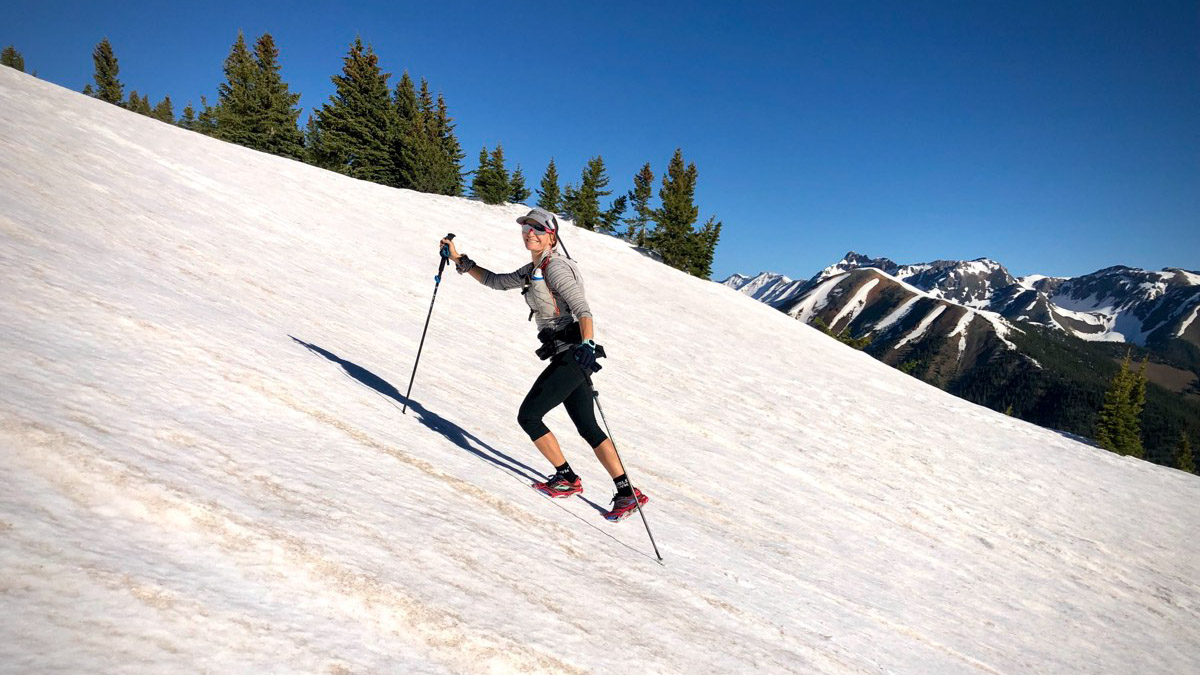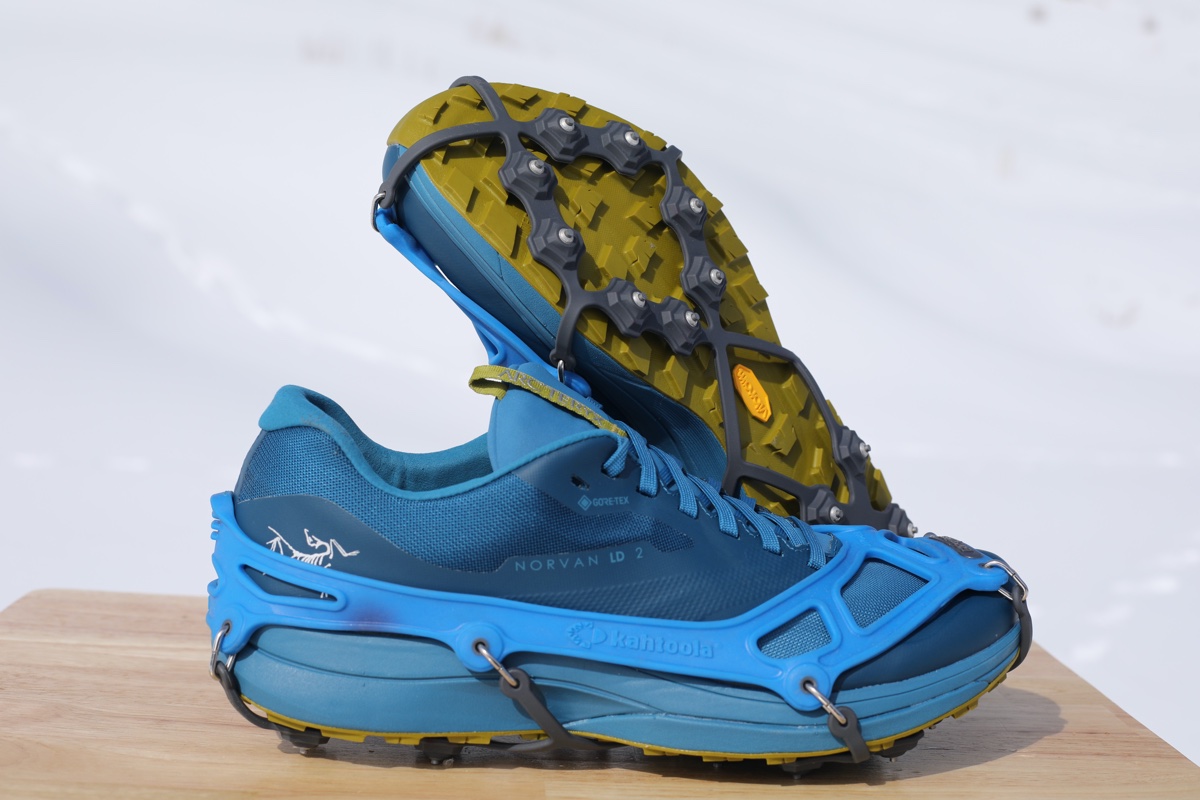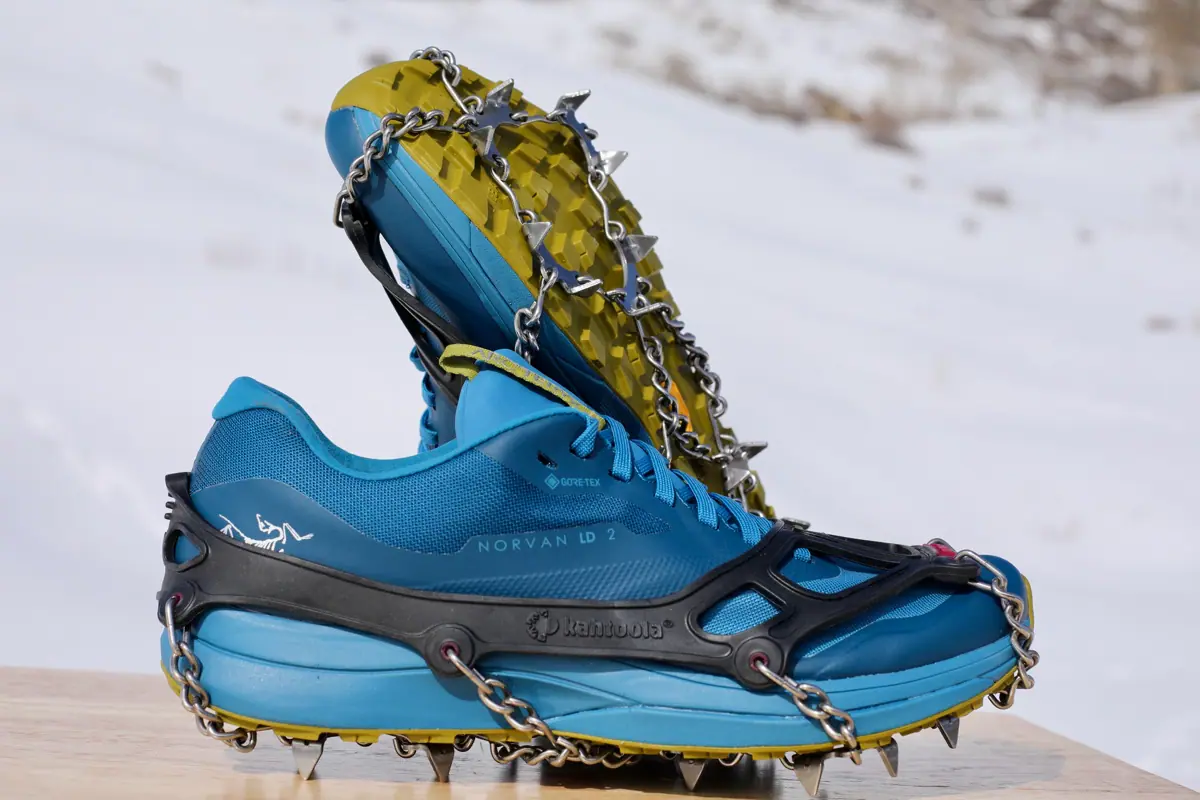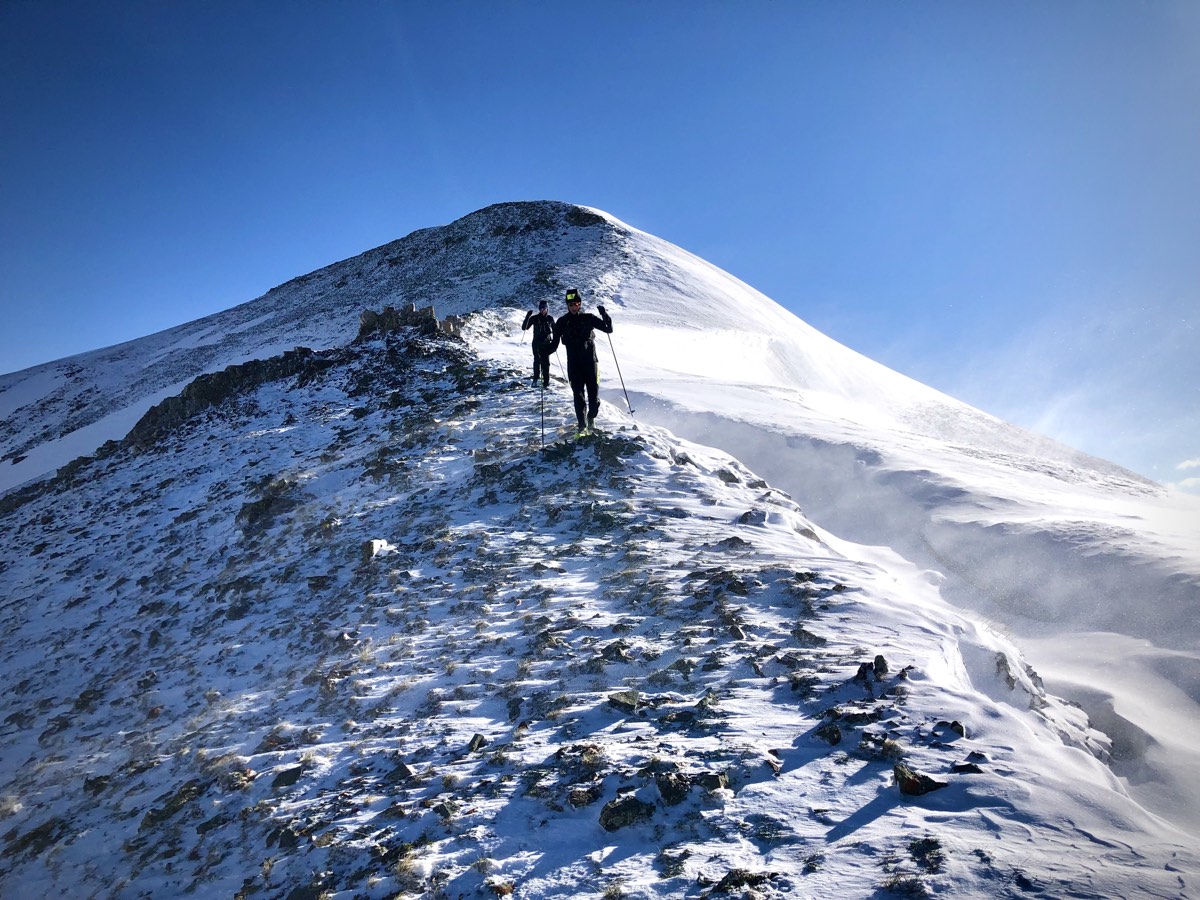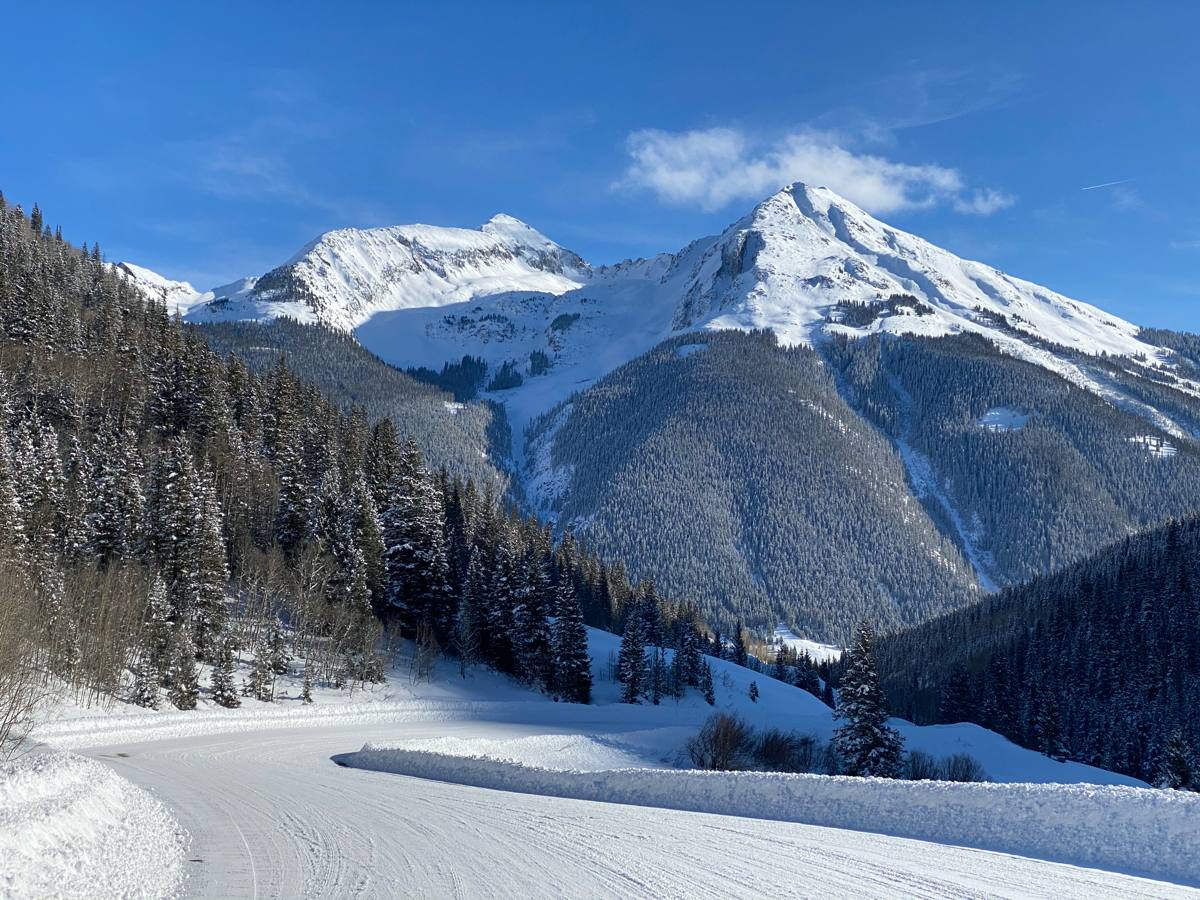Are you looking for more grip on your winter runs on snow and ice? Well, we’ve logged lots of winter miles in challenging conditions over many years to come up with the following guide to the best traction devices for winter running.
Traction devices are removable and fit over your running shoes to provide additional traction during winter running, whether on snow or ice. The active portion of traction devices is a set of metal teeth, spikes, tips, or coiled wire found underfoot. Any of a number of materials connect those bits to a harness, usually at least partially made of a wrap around the toe, heel, and sides of your running shoe to keep the business end in place. Whether you call such devices traction devices, ice cleats, running grips, or crampons, this guide will help you find the right device for your next winter run.
We found the best overall traction devices for a variety of scenarios so that you can get out there and enjoy your winter running safely, whatever the conditions. To learn more about traction devices for running before buying, check out our thoughts on how to choose the correct traction devices for your needs, our testing methodology, which led to this guide, and our answers to the most frequently asked questions about these devices.
Here are our picks for the best winter running traction devices. Scroll down to read our review of each winning product.
Best Winter Running Traction Devices
- Best Overall Winter Traction Running Devices: Black Diamond Distance Spike
- Best Value Winter Traction Running Devices: Yaktrax Pro
- Best Winter Traction Running Devices for Mixed Snow, Ice, and Pavement: Kahtoola EXOspikes
- Best Winter Traction Running Devices for Mountain Running: Kahtoola MICROspikes
- Best Winter Traction Running Devices to Carry Just in Case: Black Diamond Blitz Spike
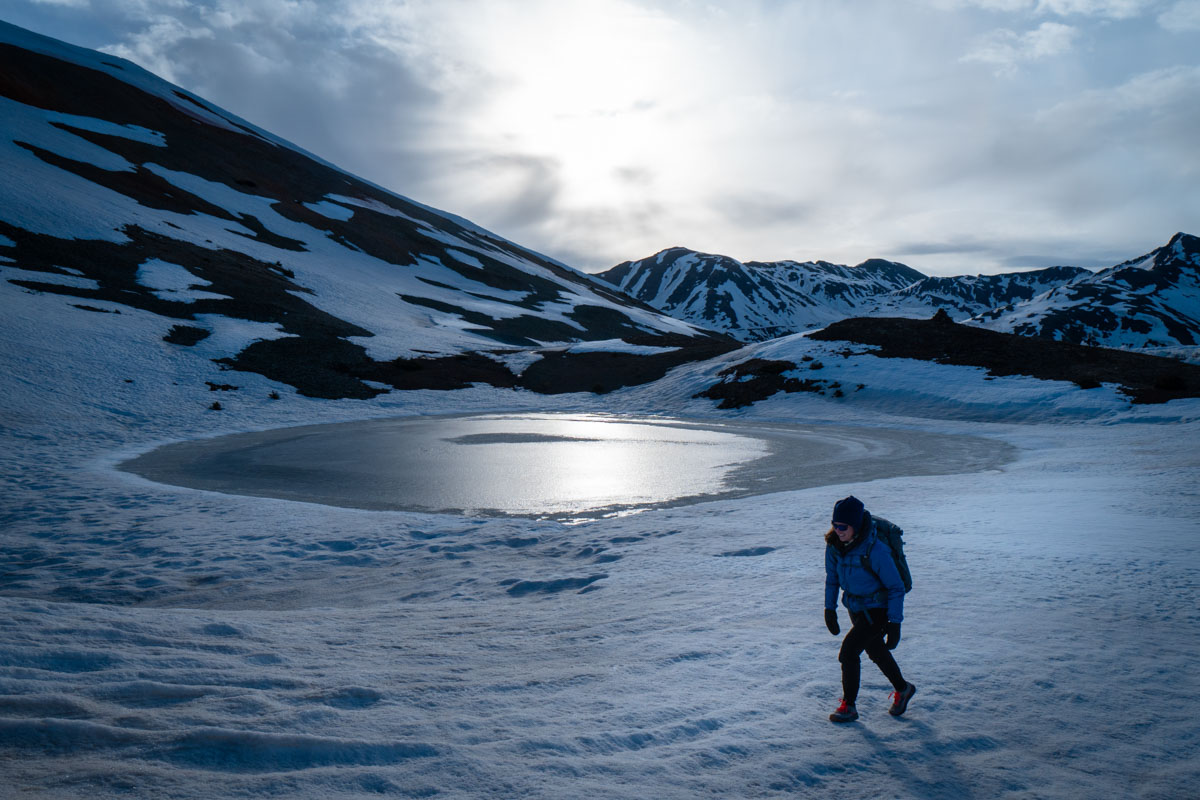
Traction devices can make traveling across snow much safer and easier. Photo: iRunFar/Eszter Horanyi
Best Overall Winter Traction Running Devices: Black Diamond Distance Spike ($100)
When launched in late 2020, the Black Diamond Distance Spike instantly jumped to the top of the winter running traction device pantheon. The Black Diamond Distance Spike is a crampon-like, chain-and-metal-spike style of traction device, but it cuts the weight of earlier running crampons roughly in half without losing any grip.
Where its predecessors used heavy elastomers and thick metal components, the Distance Spike moves to thinner metal, thinner elastomer, and a fabric toe cap. This easy-on, easy-off traction device provides outstanding traction on both packed snow and ice, as well as supplementing traction in softer snow. These have now been our go-to choice for a few winters!
Actual Weight: 3.3 ounces (93 grams) each (All weights are for traction device models compatible with U.S. men’s size 9 shoes.)
Pros:
- Excellent grip on multiple surfaces
- Very lightweight for what they do
- Easy on and easy off
- Secure fit
Cons:
- High price
- Annoyance of metal spikes on pavement
- Toe cap is a tight fit for bulky shoes
View the full Black Diamond Distance Spike review for more information.
Shop the Black Diamond Distance SpikeBest Value Winter Traction Running Devices: Yaktrax Pro ($35)
The Yaktrax Pro is unlike any other traction device on the market in that its traction comes from metal wire coiled around an elastomer frame underfoot. The broad crossing pattern underfoot provides good traction on snow, while the metal coils provide some bite when running on packed snow or ice, even if it’s less bite than traction devices with true teeth, spikes, or carbide tips.
That’s the downside, but the upside is that without metal teeth, spikes, or carbide tips, Yaktrax Pro is the most pleasant traction device for running on stretches of bare pavement. There’s no clicking, no odd high points underfoot, and no worry that you’re unnecessarily dulling your traction devices.
In addition, the small Velcro band across the top of the foot makes for a worry-free, secure fit. All in all, you get very good performance at a great price!
Actual Weight: 2.5 ounces (70 grams) each
Pros:
- Low cost
- Low weight
- Comfortable on stretches of bare pavement or trail
- Secure fit
Cons:
- Less traction on ice
- Not suitable for prolonged, burly off-trail adventures
View the full YakTrax Pro review for more information.
Shop the Yaktrax ProBest Winter Traction Running Devices for Mixed Snow, Ice, and Pavement: Kahtoola EXOspikes ($63)
For some time, there’ve been traction devices that mounted carbide tips on flat panels that went under the outsole. But the Kahtoola EXOspikes raised the game by putting the carbide tips atop 5-millimeter lugs (8 mm in total from the TPU base to the tip).
Those big lugs can make for an awkward ride atop trail shoes that already have 5 mm or longer lugs, but the Kahtoola EXOspikes are great for adding both lug traction for running on snow and carbide tip traction for running on ice to any and all road running shoes as well as to trail running shoes with more modest lugs. While the Yaktrax Pro discussed above is a great option for road running, the Kahtoola EXOspikes provide additional reassurance on ice.
Actual Weight: 3.6 ounces (102 grams) each
Pros:
- Good all-around
- Relatively light
- Very easy on and off
- Secure fit
Cons:
- Can feel a little unstable (but plenty grippy) on uneven ice
View the full Kahtoola EXOspikes review for more information.
Best Winter Traction Running Devices for Mountain Running: Kahtoola MICROspikes ($75)
Just one step down from true crampons, Kahtoola MICROspikes are the burliest traction devices fit for running … and they are completely fit for running. First launched more than a decade ago, for many of us long-time runners, the Kahtoola MICROspikes were one of our first winter running traction devices. They worked great way back when, and with three incremental updates over the past decade, they continue to work great.
However, with lots of strong traction device options on the market today, the Kahtoola MICROspikes stand out for their bomber construction. The Kahtoola MICROspikes on my shelf are the same pair I bought more than a decade ago, and even if the teeth are slightly rounded at this point, I’ve never worried that they’ll fail me whether I’m running on the snowy streets of Silverton, Colorado, or bombing down from a 14,000-foot peak.
Actual Weight: 6.0 ounces (170 grams) each
Pros:
- Excellent traction
- Very secure fit
- Burly construction
Cons:
- On the heavier side
- Can slightly curl toes upward
View the full Kahtoola MICROspikes review for more information.
Shop the Kahtoola MICROspikesBest Winter Traction Running Devices to Carry Just in Case: Black Diamond Blitz Spike ($50)
The Black Diamond Blitz Spike is the traction device you want to carry if there’s a slight chance you may need extra traction on your run. The same goes if you know there’s a mile or two or three out of a long run for which you’ll want additional traction. Why? These are the lightest removable traction devices out there, and they pack down to nothing. Heck, they’d fit in a running belt or even tucked into the waistline of running tights or pants.
There are a couple of notable downsides to the Black Diamond Blitz Spike, as they’re a bit of a pain to get on such that the toe strap is comfortable, and the odds of them staying on are increased. Even with care, it’s not uncommon for the Black Diamond Blitz Spike to slide off every couple of miles.
In addition, the cleats on the Black Diamond Blitz Spike are located solely on the forefoot and may require heel strikers to foot strike more toward the mid- or forefoot to maximize their grip on snow and ice. These factors are enough to prevent these from being a daily go-to option; however, they do work great as a just-in-case option.
Actual Weight: 1.9 ounces (54 grams) each
Pros:
- Extremely lightweight
- Extremely packable
Cons:
- More difficult to put on
- Can come off unintentionally
- Forefoot traction only
Shop the Black Diamond Blitz Spike
How to Choose: A Buyer’s Guide for Winter Running Traction Devices
So, which winter traction device is best for you? To find out, you should consider a couple of factors.
Will you be running more on snow or ice?
To be honest, all of the traction devices mentioned above will provide plenty of grip when running on snow. However, if you’ll also be mixing in sections of bare pavement or trail and you won’t encounter much ice, you’ll want to consider the Yaktrax Pro, as their lack of spikes, teeth, or carbide tips make them more comfortable when running on stretches of harder surfaces.
Running on ice is best done with traction devices that have distinct teeth, spikes, or carbide tips, with carbide tips being ideal in that they concentrate pressure in a small area to bite into the ice. The Kahtoola EXOspikes are a great offering with carbide tips. That said, the Black Diamond Blitz Spike and Kahtoola MICROspikes also perform excellently on ice.
Will you be running on pavement, concrete, or bare trail?
If you’ll be running on significant sections of bare pavement, such as running a few miles to a trailhead or climbing on bare trail up to the snowline, you might want a traction device that’s easy to get on and off, compact to store, but otherwise performs best on the snowy or icy surface on which you’ll eventually run.
If you’ll be running a mixture of patches of bare pavement, snow, and ice, you might go with the Yaktrax Pro, which is more comfortable when running on bare ground than traction devices with teeth, spikes, or carbide tips.
Will you be running in dangerous or high-risk conditions?
Here, we’d recommend the Kahtoola MICROspikes. They’re bomber, secure, and work in a mix of the burliest conditions. That said, you’ll likely get away with Black Diamond Distance Spike if you already own them.
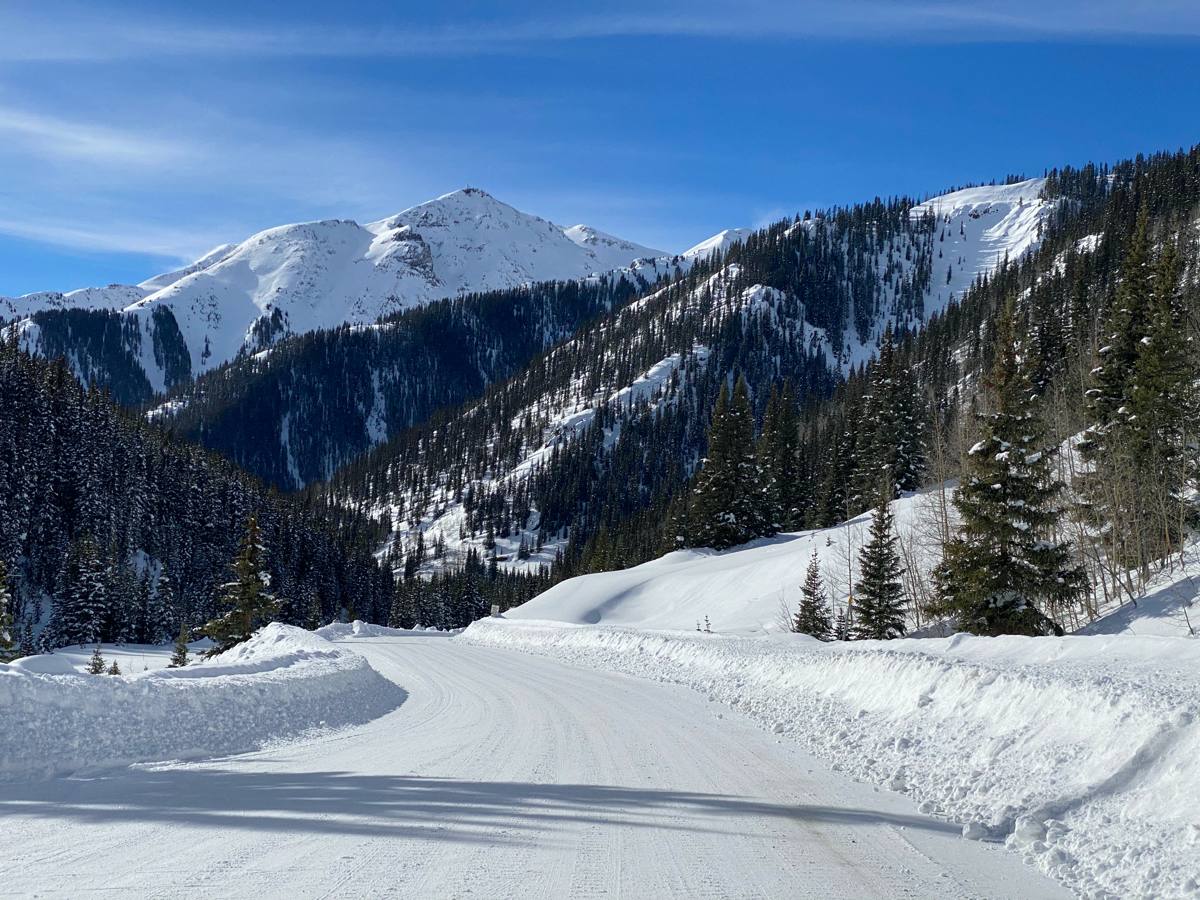
A view of the roads and mountains of Silverton, Colorado, in winter with a variety of surfaces available.
Why Trust Us
iRunFar’s experts are based in the U.S.’s Intermountain West with long, snow-filled winters where running on snow and ice for months on end is the only option. We run on slushy shoulder season paths, packed snow trails, and glazed-over roads — and that’s where we tested these traction devices.
Unlike some other product categories that we’ve tested, there aren’t hundreds of legitimate options in the winter running traction devices space. At most, there are a couple dozen options, and as tractions device models tend to stick around for many years with minimal modifications, a handful of the best options for winter running have risen to the top over the past decade.
We tested those top devices — roughly a dozen of them — to find out in what conditions they each excel. We’ve been running in versions of some of these devices since at least 2007, and so that means we’ve logged hundreds of hours in them through the years from Virginia to Alaska and from Colorado to California. Our in-depth analysis was largely conducted on the moderate-elevation, high-usage trails of Colorado’s Front Range and the burly high-elevation roads of Silverton, Colorado.
In the end, we’ve identified what we think are the best winter running traction devices for various situations. These are literally what we have in our closets if we’re not out running in them.
Please note that in the running world, product models are routinely discontinued, while new ones frequently come to market. At the same time, we here at iRunFar often keep using our top picks in our daily running … they’re our top picks, after all! Sometimes that continued use results in uncovering product failures. With all this — product discontinuations, product introductions, and product failures — in mind, we routinely update our buyer’s guides based on past and ongoing testing as well as research by our authors and editorial team. While these updates can appear to be us pushing the newest product, it’s anything but that. When we update any buyer’s guide, most of the products are likely to remain the same. That matches our goal: to get you in the best gear that you’ll be using for a long time.
Frequently Asked Questions About Winter Running and Traction Devices
Do I need traction devices for winter running?
Not necessarily. Good technique for the conditions, such as increasing the vertical aspect of your pushoff while decreasing the horizontal aspect, increasing cadence, and avoiding sudden turns and stops when it’s slippery underfoot, can help keep you upright and under control. That said, a traction device can provide reassurance, increase safety, and reduce the need to concentrate on footing. Carrying a backup traction device such as the Black Diamond Blitz Spike can give you extra peace of mind when running in the winter. We’ve written more extensively on techniques for running on snow and ice.
Are there other names for winter running traction devices?
Yes. People sometimes call traction devices ice cleats, ice running cleats, snow cleats, traction cleats, running grips, ice traction devices, ice grippers, trail crampons, or even crampons, although the last more often refers to more technical mountaineering gear.
Are there any DIY solutions for adding traction for winter running?
A time-tested approach is the screw shoe in which you screw a number of 3/8-inch or 1/2-inch hex-head screws into the lugs of each outsole. Setting up screw shoes will only take a trip to your local hardware store, a couple of bucks, and a few minutes of your time if you’ve got a drill handy.
There are also commercial options for the equivalent of screw shoes, including Icespike and La Sportiva AT Grip Hobnails. Unless you’re running exclusively on snow and ice throughout the winter, it’s arguably easier to have a pair of lightweight traction devices like the Yaktrax Pro around to put on any pair of shoes you want to use instead of dedicating a single pair of shoes to winter running.
Do I need special shoes for winter running?
While any running shoe can work for winter running, when there’s snow on the ground, and it’s not rock hard, trail running shoes with decent-sized lugs can add traction without needing traction devices. On the flip side, it can be annoying to wear most traction devices over deeply lugged trail shoes, as the combination of external spikes or teeth and deep lugs can lead to a mishmash of very tall spikes and spikes recessed between deep lugs. (Note: If you’re interested in making screw shoes as described above, you’ll want your shoe to have distinct lugs with a bit of depth to place the screw in.)
A few running shoes do use winter-specific outsole technology, such as Vibram’s Icetrek and Arctic Grip, that increase outsole grip on ice. One such example of a shoe containing this technology is the Saucony Peregrine ICE+ 3.
There is a whole category of running shoes (mostly trail running shoes) that have carbide tips embedded in the outsole. These generally provide outstanding traction on ice and can be quite good on packed snow if they’ve got some lug depth. The downsides are that the metal tips can be annoying (and wear down relatively quickly) on bare pavement, and unless you’re into orienteering, you’ll only want to wear these shoes on winter runs where traction will be an issue. You also won’t want to wear your spiked shoes into your house, stores, or, likely, even your car. Examples of running shoes with spikes include many models of Icebug running shoes, the Salomon Spikecross 5 Gore-Tex, and the La Sportiva Blizzard GTX.
There are also shoes with waterproof membranes. These can be great for shorter runs on ice or through an inch or two of snow. However, once you get into runs of an hour or two and longer, nearly all “waterproof” running shoes will become damp from sweat, if not from snow entering the ankle collar and melting. Although uncommon, occasionally, a winter running shoe comes out that has a water-resistant upper, and this can be a nice middle ground.
Despite the fact even membraned shoes will eventually get wet on the inside, some people like to wear them for winter running with the thought that they can help keep wet feet warm by reducing airflow through the shoe and holding in the heat generated by your feet. Having a basic set of winter traction devices, such as the Black Diamond Blitz Spike, can allow you to make your shoe choice based on the conditions.
How do I care for winter running traction devices?
There’s little that needs to be done for these devices as all metal components should be made of stainless steel or another non-corroding metal. Still, it can’t hurt to shake them off and let them dry after an outing before storing them. For traction devices with elastomer portions, avoid leaving them in direct sunlight and hot temperatures to prolong their life. While an uncommon situation for most of us, stretching the elastomer while below the rated temperature can also decrease its lifespan. The elastomers of all of our picks, especially the Kahtoola MICROspikes, are durable and can withstand challenging conditions.
How do I choose between the winter running traction devices that are available?
In terms of performance, there are two main considerations to take into account when choosing between the various traction devices intended for winter running.
First, think about what winter conditions you will most commonly be running in or, more importantly, on. Soft snow, hardpacked snow, and ice all interact a bit differently with traction devices. Toothed cleats tend to work well on all sorts of snow, while thin carbide tips bite better into firm ice. Those carbide tips won’t add much traction in deeper snow but will add some purchase on hardpacked snow.
Second, consider what kind and how much ice-free and snow-free firm terrain, such as pavement or rocky trails, you’ll run on, as the cleats and spikes of traction devices can be uncomfortable on such surfaces. This annoyance and possible discomfort can be mitigated if a traction device, such as the Yaktrax Pro, is easy to remove, reinstall, and store, so long as there’s relatively infrequent alternation between bare, hard ground and wintry conditions underfoot.
Other important considerations in choosing between traction devices include price, durability, weight, and portability.
What about using traction devices for walking?
While all of the traction devices we looked at would be suitable for running, check out this traction device roundup that’s more tuned toward walking and hiking if that’s your primary use. The Yaktrax Pro is a popular traction option for walkers.
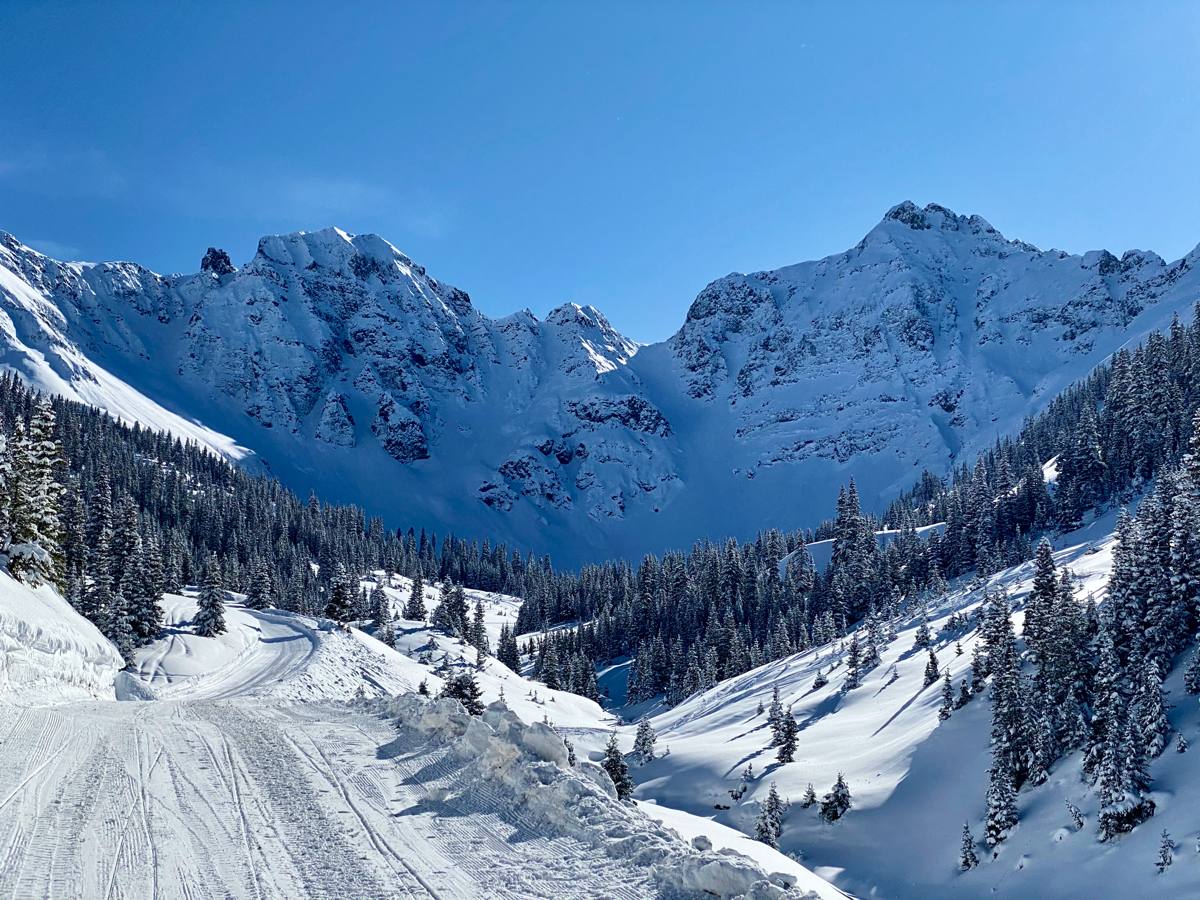
While running at high elevation in the winter, runners may encounter hardpacked snow, ice, and steep slopes with a combination of the three. Photo: iRunFar
Other Winter Running Resources
Now that we’ve hopefully helped you stay upright, here are some additional resources for winter running.
- Finding Footing: Techniques for Running on Snow and Ice
- Embracing Winter: How Do You Do It? – Lots of good commentary from personal perspectives in the comments
- Winter Training: Making This Your Most Effective Off-Season Yet
- Seasonal Affective Disorder and the Power of Positive Self-Talk
- iRunFar’s treadmill articles, with Treadmill Training: Welcome to the Machine being a good start
- Snowshoe Running Basics: The Why and How
- Snowshoe Racing
Fun Winter Running Reading
Finally, here are some entertaining stories about winter running.
- Why I Hate/Love Running in Winter – An entertaining take on running through the winter
- What a Drag: Joe Grant’s Susitna 100 Experience – Joe Grant writes of his struggles pulling a sled with mandatory equipment for 100 miles in Alaska’s Susitna 100 Mile
- Geoff Roes’s 2012 Iditarod Trail Invitational (350-miles) Report – Geoff Roes’s blow-by-blow report of his 2012 Iditarod Trail Invitational run through the Alaskan winter
- David Johnston, 2014 Iditarod Trail Invitational 350-Mile Champion, Interview – An interview with David Johnston after his record-setting win (4 days, 1 hour, and 38 minutes) of this 350-mile race through Alaska’s winter wilderness
- Beautiful and Brutal: A 2018 White Mountains 100 Race Report – Bryon Powell shares the experience of running his first Alaskan winter 100 miler, the White Mountains 100 Mile, in 2018
Call for Comments
- What’s your favorite winter running traction device or devices?
- What winter running advice do you have?
